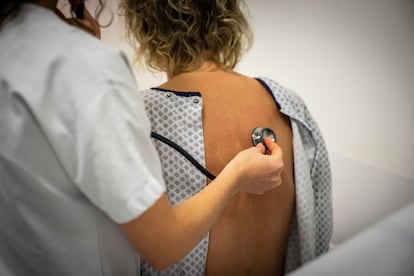Why women with heart problems are diagnosed later and with less accuracy
According to a new study, the GRACE score, which is used by cardiologists to measure the risk of death after cardiac arrest, underestimates the risk of mortality in female patients

Few diseases are more time-dependent than a heart attack: if not treated in time, the outcome can be fatal. Severe chest pain usually sets off alarm bells for both the patient and the health care system – especially if the victim is a man. In women, everything from diagnosis to treatment is often slower and less straightforward. For more than a decade, the scientific community has noted gender discrimination in cardiovascular care for women. “Despite the fact that 35% of deaths in women each year are due to cardiovascular disease, women continue to be underdiagnosed and undertreated,” stated a 2021 report in The Lancet medical journal.
And the bias has continued into 2022: research presented several weeks ago at the European Congress of Cardiology held in Barcelona reveals that one of the international scales of measuring the probability of death after a coronary issue underestimates the risk of in-hospital mortality in women. The experts explain that, on the one hand, women get checked out later and are less aware of cardiovascular disease, but doctors also tend to underestimate the symptoms or, when they have a diagnosis, to be more conservative in their treatment.
In the event of a heart attack, the clock is ticking and every minute counts: life can be snuffed out in a matter of seconds. An artery of the heart is blocked because a thrombus has formed – a clot that interrupts the correct flow of blood to the heart. The longer it goes on, the longer the heart is starved of blood and the more heart tissue is damaged.
Scientists have shown that besides a delay in consultation and treatment for women, there is also an issue with the actual tools used to measure risk: an article published this week in The Lancet reveals that the GRACE score, a parameter for stratifying the risk of hospital death in people who have suffered a heart attack, underestimates the risk of death in women, “favoring an incorrect stratification to the low to intermediate risk group, for which early invasive treatment is not indicated,” according to the study. In cardiovascular diseases in general, although the incidence is higher in men, mortality is higher in women.
According to Ana García, a researcher at the National Center for Cardiovascular Research and head of the Cardiology Service at Barcelona’s Hospital Clinic, the results of the study were “not unexpected. GRACE, like most of the scales, was derived from studies where male predominance is key,” she adds.
The experts consulted say that this gender discrepancy in care is being addressed, but that there are a variety of factors at play. To start with, there is the actual perception of the disease: cardiovascular diseases are one of the main causes of death in women, but women are not aware of this. There is “an information bias” from the outset, explains Antonia Sambola, coordinator for the Spanish Society of Cardiology’s Working Group on Women in Cardiology: “Women think that the leading cause of death for them is breast cancer and this is not the case,” she says.
According to García, this lack of awareness, together with the fact that symptoms can be less specific in women such as nausea and general malaise, mean that women do not seek emergency help. Sambola, who deals with this type of cardiac emergency at Vall d’Hebron, the largest hospital in Catalonia, is categorical: “When you have chest pain, you have to get it checked out, just as a man would. The rest of the symptoms are additional. What is conclusive and has to be taken into account in a patient is the chest pain.”
But there is also a tendency among doctors to underestimate the seriousness of a woman’s symptoms. “There is a certain bias; when it comes to women, there is not an immediate association with cardiovascular disease,” says Sambola. “It is common for women who come to the emergency unit with symptoms to have been checked out for angina a few days earlier, with the doctors telling them that the pain could be due to anxiety.”
According to García, women are also less likely to get surgery and fewer interventional procedures are done. “There is a perception that the patient is more fragile and is treated conservatively,” she says.
A study published in the journal Heart found that, after an infarction, women were less likely to receive the appropriate tests and medical procedures, such as perfusion therapy, coronary angiographies or antiplatelet treatments. “It is estimated that 8,243 female deaths could have been avoided during the study period” if they had had to go through the same hoops as their male counterparts.
Less access to clinical trials
Gender discrimination also affects research: women participate less in clinical trials. “In studies that test whether or not a certain treatment is beneficial, the percentage of women participating is less than 30%,” says Sambola.
Why such a lack of female participation? According to experts, besides not having the time due to work and family responsibilities, there is also an issue surrounding the access requirements: “Women under 55, for example, are not recruited because they menstruate and this can influence the result,” explains Sambola. “With ischemic heart disease, many antithrombotics and anticoagulants are used, which will increase menstrual bleeding and they will have more anemia and more side effects.”
The cardiologists call for more awareness in self-care, more education and training for professionals and a recalibration of scales such as GRACE to refine the parameters regarding gender perspective.
Tu suscripción se está usando en otro dispositivo
¿Quieres añadir otro usuario a tu suscripción?
Si continúas leyendo en este dispositivo, no se podrá leer en el otro.
FlechaTu suscripción se está usando en otro dispositivo y solo puedes acceder a EL PAÍS desde un dispositivo a la vez.
Si quieres compartir tu cuenta, cambia tu suscripción a la modalidad Premium, así podrás añadir otro usuario. Cada uno accederá con su propia cuenta de email, lo que os permitirá personalizar vuestra experiencia en EL PAÍS.
¿Tienes una suscripción de empresa? Accede aquí para contratar más cuentas.
En el caso de no saber quién está usando tu cuenta, te recomendamos cambiar tu contraseña aquí.
Si decides continuar compartiendo tu cuenta, este mensaje se mostrará en tu dispositivo y en el de la otra persona que está usando tu cuenta de forma indefinida, afectando a tu experiencia de lectura. Puedes consultar aquí los términos y condiciones de la suscripción digital.
More information











































